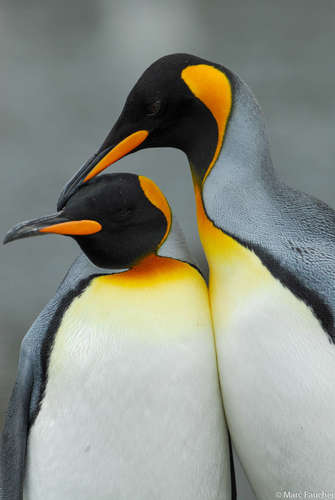
King Penguin
The King Penguin (*Aptenodytes patagonicus*) is the second largest penguin species, renowned for its striking appearance and remarkable breeding habits. These birds play a crucial role in the subantarctic ecosystem, serving as both predator and prey. Unlike some penguin species that build nests, King Penguins incubate a single egg on their feet, enduring harsh conditions. Their large colonies are a significant feature of subantarctic islands, contributing to nutrient cycling and serving as a draw for ecotourism in some regions.
85-95 cm
Length
Not applicable (flippers) cm
Wingspan
Least Concern
Conservation Status
Distribution
King Penguins are found on subantarctic islands between 45 and 55 degrees south latitude. Major breeding colonies are located on South Georgia, Crozet Islands, Prince Edward Islands, Kerguelen Islands, and Macquarie Island. They forage in the surrounding Southern Ocean, often diving to considerable depths.
Lifespan
Approximately 20 years in the wild.
King Penguin's Habitat
Habitat Types
Subantarctic Islands, Open Ocean (foraging)
Climate Zones
Subantarctic, Temperate (marine)
Adaptations
King Penguins have dense, waterproof plumage and a thick layer of subcutaneous fat for insulation in cold waters. Their streamlined bodies and powerful flippers enable efficient swimming and diving. They also possess salt glands to excrete excess salt ingested while feeding at sea. Consult a professional for medical or expert advice.
Variations
Two subspecies are generally recognized: *A. p. patagonicus* (found on South Georgia) and *A. p. halli* (found on other islands). The two subspecies differ slightly in size and plumage.
Appearance
Breeding Plumage
Adult plumage is similar year-round, but may appear duller after molting.
Seasonal Feather Changes
Adults undergo a complete molt annually after breeding.
Sex Based Plumage Differences
Males and females have similar plumage.
Notable Features
Bright orange-yellow auricular patches, Black head and throat, Silvery-grey back, White belly, Orange lower mandible
Diet and Feeding
Primary Foods
Small fish (especially myctophids - lanternfish), Squid, Krill
Foraging Behavior
King Penguins are pursuit divers, capable of reaching depths of over 300 meters and staying submerged for several minutes. They often forage in deep waters during the day, following the vertical migration of their prey.
Specializations
Their streamlined bodies and powerful flippers are adaptations for efficient underwater pursuit of prey.
Seasonal Diet Variations
Diet composition varies depending on prey availability, with fish often being more important during chick-rearing.
Behavior
Social Structure
King Penguins are highly social, forming large breeding colonies that can number in the tens of thousands of pairs. They are also social while foraging at sea.
Communication
Vocalizations (trumpeting calls for mate recognition and chick identification), Visual displays (bowing, preening, head shaking)
Migration
King Penguins do not undertake long-distance migrations like some other penguin species. They remain relatively close to their breeding islands, although foraging trips can cover hundreds of kilometers.
Territorial or Group Behaviors
While they don't defend a specific nest site, King Penguins exhibit some territorial behavior within the colony, maintaining a small space around themselves.
Conservation
Threats
Climate change (affecting prey availability), Overfishing (reducing food sources), Incidental capture in fishing gear, Oil spills
Protection Programs
Marine Protected Areas (MPAs) around some breeding colonies, International agreements to regulate fishing in the Southern Ocean
Local National Laws
Protected under national legislation in several countries where they breed (e.g., Australia, France, UK).
Population Trend
Increasing
Population Estimates
Estimated at over 2 million breeding pairs globally.
Interesting Facts
King Penguins have one of the longest breeding cycles of any bird.
This is due to the long chick-rearing period, which extends through the winter.
They can dive deeper than most other penguin species.
This allows them to access prey unavailable to shallower-diving penguins.
King Penguin chicks are covered in thick, brown down.
This down provides insulation until they develop their waterproof adult plumage.
King Penguins can recognize their chick or mate amongst thousands by their unique call
This is very important in the large and noisy colonies
Faqs about King Penguin
How long can King Penguins hold their breath?
They can typically stay underwater for 5-7 minutes, and exceptionally up to 10 minutes.
Do King Penguins mate for life?
While they often return to the same breeding colony, pair bonds are not always lifelong. Mate fidelity is relatively high, but 'divorce' can occur.
What eats King Penguins?
Leopard seals and orcas are the main predators of adult King Penguins at sea. Skuas and giant petrels may prey on eggs and chicks.
Copyright @ Nature Style Limited. All Rights Reserved.
 English
English